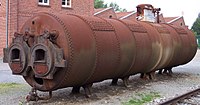
Photo from wikipedia
Wind-induced vibration (WIV) and power extraction performances of a circular cylinder with symmetrically installed fin-shaped rods (FSR) were experimentally and numerically investigated under different coverages. The FSR coverage which is… Click to show full abstract
Wind-induced vibration (WIV) and power extraction performances of a circular cylinder with symmetrically installed fin-shaped rods (FSR) were experimentally and numerically investigated under different coverages. The FSR coverage which is expressed as an angle (α) is measured from the upstream edge to the downstream edge of the rod. The effect of FSR installation angle (θ) which is the angle from the stagnation point of cylinder to the upstream edge of the rod was also considered in this work. The FSR cylinder is exposed in uniform wind and allowed to vibrate in cross-flow direction. The output electric power is realized by piezoelectric patch. It is found that, for most cases, the output power of FSR cylinder increases monotonously with the rise of α for a given wind velocity (U). In addition, the tendency of output voltage varies with the wind velocity is highly similar to that of output power. The maximum values of output voltage and power are 19.70 V and 1.90 mW can be obtained when α= 20° (θ= 60°). The WIV responses of FSR cylinder show that the amplitudes of FSR cylinder increase with the rise of α for low installation angle (θ= 0°, 30°) and the maximum amplitudes exceed 2D (D: diameter of circular cylinder) can be observed for α= 40°/50° (θ= 30°) and α= 20° (θ= 60°). The reduced frequency of cylinder for θ= 0° and 30° does not sensitive to the coverage (α). It is worth noting that multiple frequencies can be captured for high coverage. Due to the boundary layer separating point moves in downstream direction with the increase of U and α, the vortex pattern switches from 2S to 2P.
Journal Title: Smart Materials and Structures
Year Published: 2021
Link to full text (if available)
Share on Social Media: Sign Up to like & get
recommendations!